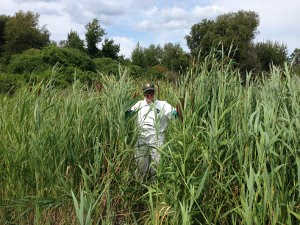
Invasive species include terrestrial and aquatic plants, animals, diseases, and other organisms and are defined as “those species that occupy or could occupy park lands directly or indirectly as a result of deliberate or accidental human activities” (NPS Management Policies 2006). Invasive species, commonly referred to as nonnative, alien, and exotic species, are defined as organisms that are not native to an ecosystem and whose introduction does or is likely to cause economic or environmental harm or harm to human health (EO 13112). Climate change refers to a significant long-term shift in weather variables and includes not only shifts in mean conditions (e.g., increasing mean annual temperature and sea level) but also changes in climate variability (e.g., more intense storms and flooding). Direct, indirect, and interactive effects of climate change and invasive species in parks include:
- alteration of ecological processes
- displacement or harm to native species
- damage to cultural resources and disruption of cultural landscapes, and
- creation of public safety hazards.
Climate and invasive species in parks: Recent trends and future projections
Invasive species examples:
Units of the National Park Service across the U.S. are already experiencing the influences of climate change and invasive species.
- Cheatgrass has drastically altered landscapes throughout the American west, increasing fire frequencies and altering habitat for imperiled species such as the sage grouse.
- Invasive tree pests and disease, such as hemlock woolly adelgid, emerald ash borer, white pine blister rust, laurel wilt and gypsy moth, are damaging and killing host trees in many parks.
- Zebra mussels significantly alter parks’ aquatic ecosystems and impact water-based facilities.
Climate examples:
- A large majority of national parks (>80%) are already at the extreme warm end of their historical climatic conditions.
- Native plant, mammal, and bird species within parks are shifting upslope and northwards in response to climate change.
- Sea level is rising and coral bleaching events related to ocean warming are occurring at multiple parks.
Climate change and invasive species will interact, altering the direction and rate of change of park resources. For example:
- Park forests in the eastern US projected to undergo the greatest climate and tree species habitat changes in the coming decades also have very high numbers of invasive tree pests and plant species;
- Changes in the fire regime due to invasive brome grasses are likely to exacerbate climate stress on Joshua trees in the Mojave region;
- Native trout in western national parks are likely to experience range contractions due directly to warming trends and indirectly through competition with invasive fish better adapted to warmer water (e.g., brown trout).
Climate change adaptation, ecosystem restoration, and cultural resource protection: Achieving multiple goals through invasive species management
Climate change adaptation is a management adjustment in response to ongoing and projected climate change and related effects, which moderates harm or exploits beneficial opportunities. Successful climate change adaptation requires development of locally appropriate goals and strategies, collaboration with managers from neighboring jurisdictions, and includes a spectrum of strategies from resisting to actively directing change. Invasive species management is already a recurring action at most parks and climate-informed decision making can lead to both more effective treatments and accomplishment of multiple climate adaptation goals. Examples include:
- promote native species persistence within potential climate refugia by controlling invasive species
- foster transitions among native natural communities by managing nonnative invasions within areas likely to experience major climate-mediated changes
- select nonnative pest and disease targets within a park unit based on host species likely to retain suitable habitat under future climates
- examine which invasive species and areas within parks may require greater management in the future and as importantly which invasives may decline in identified areas under a changing climate
Last updated: August 6, 2021
